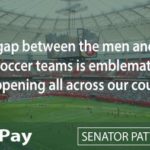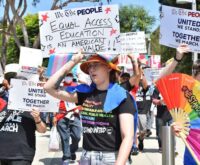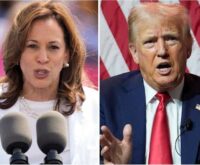Looking back at the fall of Saigon, a former general in the South Vietnamese Army says that the possibility of a free Vietnam is now threatened by China’s imperial ambitions. That’s bringing Vietnam and the United States closer together.Commentary, Thi Q. Lam, Pacific News Service
MILPITAS, Calif.– April 14, 2005 – On the evening of April 29, 1975, I boarded one of the last navy ships leaving Saigon, while enemy missiles were landing on the northern outskirts of the city with deafening explosions. The next morning, as our ship was leaving Vietnam territorial waters, I looked back at the receding Vietnamese coastline and felt tears in my eyes.
My heart went out to my comrades-in-arms and fellow countrymen left behind. I also felt very pessimistic about the fate of our pro-Western neighbors, countries that, I thought, might fall like dominoes in face of seemingly unstoppable North Vietnamese Army divisions equipped with the latest Russian and Chinese weaponry. Thirty years later, no dominoes have fallen. Instead, the Soviet Empire has collapsed and the very existence of Vietnam as a free country is being threatened by its former allied and historical enemy to the north. Although it doesn’t publicly proclaim it, China — as in the case of Taiwan — historically has considered Vietnam a renegade southern province. They named it An Nam, or “the Pacified South.” China’s killing of Vietnamese fishermen in the Vinh Bac Bo (Gulf of Tonkin) in January, in fact, has added to a consistent pattern of Chinese southern expansionism: conquest of the Paracel Islands in 1974; invasion of the northern provinces of Vietnam in 1979 and subsequent annexation of 8,000 square kilometers of borderland; occupation of the Spratley archipelagoes the same year and acquisition of 12,000 square kilometers of territorial waters in the Vinh Bac Bo conceded by Hanoi under the 2000 Vinh Bac Bo Pact. Not content with forcing territorial concessions from Hanoi, China is also building up its naval force and setting up a string of naval bases along the sea lanes in the Eastern Sea to protect oil shipments from the Middle East. The Washington Times recently revealed that a previously undisclosed internal report prepared for Defense Secretary Donald H. Rumsfeld noted that “many Pentagon analysts believe China’s military buildup is taking place faster than earlier estimates, and that China will use its power to project force and undermine U.S. and regional security.” It is not surprising that the United States and Japan have joined forces in the face of an emerging Chinese threat. In a demonstration of its willingness to confront China’s rapidly growing might, Japan, in a joint agreement with the United States, declared last February that Taiwan is a mutual security concern. “It would be wrong for us to send a signal to China that the United States and Japan will watch and tolerate China’s military invasion of Taiwan,” says Shinzo Abe, the acting secretary general of Japan’s ruling Liberal Democratic Party and a likely successor to Prime Minister Junichiro Koizumi. Recent mass protests at the Japanese embassy in Beijing triggered by Japan’s inability to admit in newly approved school textbooks its past war crimes further heightened tensions between the two emerging Asian rivals. Concerns about Beijing’s new aggressiveness have sparked new military re-alignments in the strategic Asia-Pacific region. Despite the Free World’s professed commitment to “constructive engagement” with China, the post-World War II policy of “containment” remains a popular ploy in today’s global, political chess game. Vietnam has thus regained its strategic value in U.S. eyes as a missing link in the containment scheme and a counterbalance to the even graver threat of Chinese expansionism. Vietnam appears only too willing to accommodate. The recent port of calls of U.S. Navy vessels in Saigon and Danang, the Vietnamese Defense Minister’s visit to the Pentagon in 2003 and the planned Washington trip by Prime Minister Phan Van Khai this summer signal a warm-up of military relations between the former foes. But an effective and lasting strategic cooperation, such as NATO or the U.S.-Japan Alliance, requires that the partners share the same moral values and political ideology. In other words, only a free and democratic Vietnam, enjoying popular support and the support of the community of free nations can stand up to China’s aggression and effectively contribute to regional security. In this regard, President Bush’s commitment to spreading democracy to the “darkest corners of the world” should include Vietnam. That would benefit U.S. strategic interests and at the same time liberate 80 million Vietnamese from Communist oppression. Thirty years almost to the day after I left Saigon, a young Vietnamese American came home on another boat, cruising upstream on the muddy and tortuous Saigon River. He was U.S. Lt-Cmdr. Quoc Bao Tran, and his ship was the U.S.S. Gary. The U.S. naval vessel was making a port call in the former capital city of South Vietnam. Tran may feel he was a stranger in the country where he was born and which he fled when he was only a child, but, by a strange twist of fate, the future of Vietnam no doubt hinges on young Vietnamese-Americans like him. They are bringing a message of hope to a people longing for freedom.
Other Readings of Interest from the Archives
PNS contributor Thi Q. Lam is author of the memoir “The 25-Year Century: A South Vietnamese General Remembers the Vietnam War.” He resides in Milpitas, Calif., where he teaches high school. |
||
|









